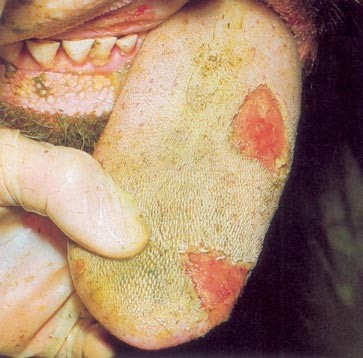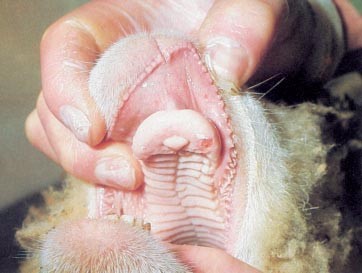Foot-and-mouth disease



Foot-and-mouth disease (FMD) is a highly contagious animal disease that affects cloven hoofed animals including cattle, buffalo, camels, sheep, goats, deer and pigs. An incursion of the virus would have severe consequences for Australia’s animal health and trade.
In May 2022, an outbreak of the virus was reported in cattle in Indonesia.
FMD can spread through close contact between animals and be carried on animal products or by the wind.
Livestock industries should be alert to the signs of FMD.
Anyone keeping or working with cattle, sheep, goats or pigs should be aware of the signs of FMD:
- blisters or ruptured blisters in and around the mouth area, teats of females, between the toes and around the top of the hoof
- increased drooling
- rapid weight loss
- lethargic and reluctant to walk
What is foot-and-mouth disease?
Foot-and-mouth disease (FMD) is a highly contagious virus disease of animals. It is one of the most serious livestock diseases. It affects cloven-hoofed animals (those with divided hoofs), including cattle, buffalo, camels, sheep, goats, deer and pigs. It is found in many parts of the world, and has been reported in countries in Africa, the Middle East, Asia and South America. While it can cause serious production losses the most significant impact of the disease occurs because of its effect on trade in livestock and livestock products. Countries without the disease, which include many of Australia’s major trading partners do not import from, or severely restrict imports from FMD-infected countries.
How is it transmitted?
FMD is a viral disease that spreads rapidly between animals. Virus is excreted in breath, saliva, mucus, milk and faeces. The virus can be excreted by animals for up to four days before clinical signs appear. Animals can become infected through inhalation, ingestion and direct contact. The disease spreads most commonly through the movement of infected animals. In sheep the symptoms can be absent or very mild, and undetected infected sheep can be an important source of infection. FMD virus can also be spread on wool, hair, grass or straw; by the wind; or by mud or manure sticking to footwear, clothing, livestock equipment or vehicle tyres.
Pigs are regarded as ‘amplifying hosts’ because they can excrete very large quantities of the virus in their exhaled breath. Cattle are very susceptible to, and able to be infected by breathing in small quantities of the virus. In some animals (‘carriers’), the virus can continue to be carried for long periods (months or years) after apparent recovery.
How infectious is it?
FMD spreads rapidly from one animal to another, especially in cool, damp climates and/or when animals are penned or housed closely together. The virus survives well at temperatures below 4 degrees Celsius, but is inactivated as temperatures rise. It is also rapidly inactivated at relative humidity less than 60 per cent.
How does it affect animals?
Although FMD impacts all ages it can be particularly lethal in young animals and can cause serious production losses. The clinical signs are fever followed by the appearance of vesicles (fluid-filled blisters) between the toes and on the heels, on mammary glands and especially on the lips, tongue and palate. These vesicles often combine to form large, swollen blisters that erupt to leave raw, painful ulcers that take up to 10 days to heal.
Foot lesions leave animals lame and unable to walk to feed or water. Tongue and mouth lesions are very painful and cause animals to drool and stop eating. Adults usually begin eating again after a few days, but young animals may weaken and die, or be left with foot deformities or damage to the mammary glands.
FMD is important in international trade in animals and animal products, with countries that are free of the disease banning or restricting imports from affected countries. This means an outbreak would have serious economic implications for a major livestock exporting country like Australia.
Is there any treatment?
There is no specific treatment for FMD. Vaccines can protect against the disease but do not necessarily prevent animals from being infected. Vaccination is used in many countries to control the disease in an endemic situation. In order for a country to regain FMD-free status and limit the economic impacts, it is important to eradicate the virus as quickly as possible. Movement controls and removal of infected animals (along with other complementary control measures such as cleaning and disinfection) are essential to eradicate this disease. Vaccination can be an important tool to assist in containing and eradicating FMD, but the use of vaccines will have trade implications and must be carefully managed.
What should be done if an outbreak occurs?
If you notice any unusual disease signs, abnormal behaviour or unexplained deaths in your livestock, contact your veterinarian, stock inspector, local Department of Industry, Tourism and Trade, or the Emergency Animal Disease Watch Hotline on 1800 675 888.
The most important people in identifying and notifying FMD are stock owners and others who work with livestock. Any suspicious symptoms should be immediately reported to the local vet so or the Emergency Animal Disease Watch Hotline, so that appropriate biosecurity arrangements to contain the spread of disease are instigated as quickly as possible.
What the Department of Industry and Trade is doing?
Since the detection of FMD in Indonesia, the department has kept the Territory cattle industry updated with the latest details through emails, briefings with industry associations, social media, webinars and on-line information sessions in addition to attendance at some NTCA branch and executive meetings. Although FMD has not been detected in Australia the Department is working closely with industry to strengthen biosecurity. Department staff including Agriculture Fisheries and Biosecurity Deputy CEO Luke Bowen attended the Alice Springs, Tennant Creek, Katherine and Darwin Shows talking directly to members of the cattle industry about the FMD risk and the need to refresh property level biosecurity plans. The Chief Veterinary Officer, Dr Sue Fitzpatrick attended the Katherine show to speak with pastoralists about their concerns and what can be done to strengthen their on-property biosecurity measures and surveillance. Demonstration walk over disinfectant mats were on display at the Katherine and Darwin Shows. On-line industry information sessions and webinars have been rolled out in July 2022 and were attended by over 500 participants. More sessions are planned, along with a range of emergency animal disease training opportunities and the establishment of industry networks in partnership with the NT Cattlemen’s Association.
Early detection is essential to reduce the potential impact of this disease
Australia’s response plans call for the rapid detection, diagnosis and eradication of this devastating livestock disease. Eradication would involve detection of infected animals and their humane slaughter and biosecurity disposal.
How long will it take to respond to an outbreak once it is detected?
The response will be immediate on receipt of advice of a suspected case. The length of time taken to control and eradicate the disease will depend on how long the virus has been present before it is detected and the degree of spread.
If there is a single point outbreak authorities should be able to isolate and eradicate the disease quickly. If the disease has already taken hold and spread across a state or over borders, it will take much longer.
Early identification and reporting, and the need for vigilance on everyone’s part, are vitally important
What you can do:
- Update your property biosecurity plan now
- Use signs to direct visitors to a designated sign in area and limit visitor contact with livestock unless absolutely necessary.
- Keep a visitor register.
- Use a visitor checklist. This may include not allowing anyone who has been overseas to come onto your property for 7 days after arriving back into Australia.
- Make your own DIY footbath, and get visitors to clean and disinfect all footwear and equipment as soon as they come onto your property.
- Don’t feed pigs swill
- Keep pigs out of rubbish dumps
- Don’t import meat or animal products from overseas
- Travel to overseas farms or rural areas must be declared on entry
- Suspect signs, symptoms or death should be reported to local veterinarians or the Emergency Animal Disease (EAD) hotline on 1800 675 888.
